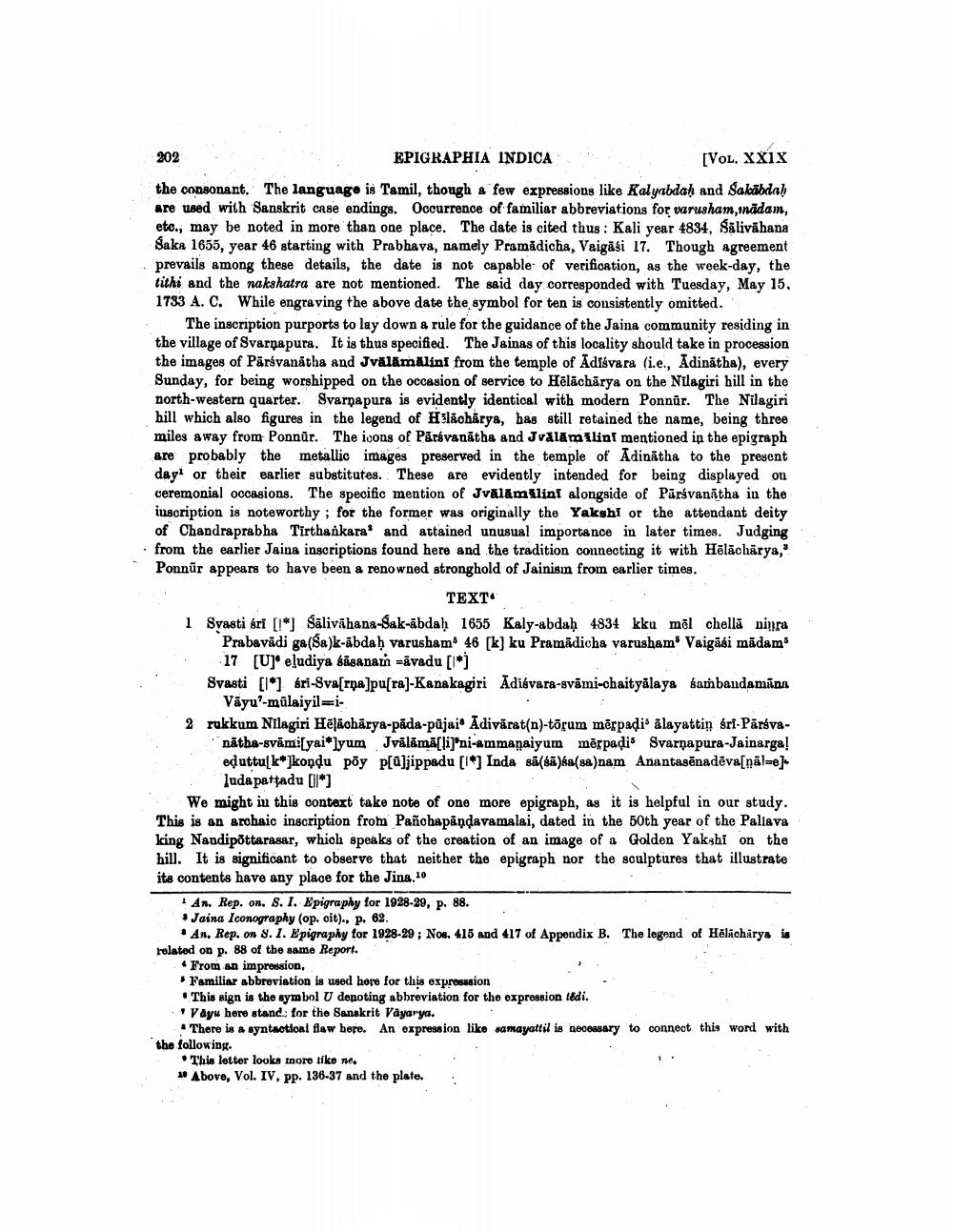________________
202
02
EPIGRAPHIA INDICA
[Vol. XXIX
the consonant. The language is Tamil, though a few expressions like Kalyabdah and Sakābdah are used with Sanskrit cnse endings. Occurrence of familiar abbreviations for varusham,inādam, etc., may be noted in more than one place. The date is cited thus: Kali year 4834, Salivāhana Saka 1655, year 46 starting with Prabhava, namely Pramādicha, Vaigāsi 17. Though agreement prevails among these details, the date is not capable of verification, as the week-day, the tithi and the nakshatra are not mentioned. The said day corresponded with Tuesday, May 15, 1733 A. C. While engraving the above date the symbol for ten is consistently omitted.
The inscription purports to lay down & rule for the guidance of the Jaina community residing in the village of Svarnapura. It is thus specified. The Jainas of this locality should take in procession the images of Pārsvanátha and Jvälāmalini from the temple of Adisvara (i.e., Adinātha), every Sunday, for being worshipped on the occasion of service to Hēlāchārya on the Nilagiri hill in the north-western quarter. Svarnapura is evidently identical with modern Ponnür. The Nilagiri hill which also figures in the legend of Hslkohärys, bas still retained the name, being three miles away from Ponnür. The icons of Pārsvanātha and Jvalamilint mentioned in the epigraph are probably the metallic images preserved in the temple of Adinātha to the present day or their earlier substitutes. These are evidently intended for being displayed on ceremonial occasions. The specific mention of Jvālāmalinalongside of Pārsvanātha in the inscription is noteworthy; for the former was originally the Yakshi or the attendant deity of Chandraprabha Tirthankaraand attained unusual importance in later times. Judging from the earlier Jaina inscriptions found here and the tradition connecting it with Hēlāchārya," Ponnür appears to have been a renowned stronghold of Jainism from earlier times.
TEXT" 1 Syasti sri [!*] Sālivāhana-Sak-ābdaḥ 1655 Kaly-abdah 4834 kku mol chellā viņra
Prabavādi ga(Sa)k-abdaḥ varusham 46 [k] ku Pramādicha varusham. Vaigāki mādam
17 [U]* eļudiya sāsanan =āvadu [1*) Svasti [1*] Sri-Sva[rņa]pu[ra]-Kanakagiri Adiávara-svāmi-chaityālaya sambandamāna
Vāyu'-mūlaiyil=i2 rukkum Nilagiri Hēlāohārya-pada-püjai. Adivărat(n)-töfum mērpadi alayattin Sri-Pārsva
nåtha-svämisyai"lyum Jvälāmā[li]'ni-ammanaiyum mörpadis Svarnapura-Jainarga! eduttu k*]kondu põy p[@]jippadu [1] Inda sā(sā)sa(sa)nam Anantasēnadēva[nāl=e).
Judapattadu [11*] We might in this context take note of one more epigraph, as it is helpful in our study. This is an archaic inscription from Pañchapāndavamalai, dated in the 50th year of the Pallava king Nandipõttarasar, which speaks of the creation of an image of a Golden Yakshi on the hill. It is significant to observe that neither the epigraph nor the sculptures that illustrate its contents have any place for the Jina.10
An. Rep. on. $. I. Epigraphy for 1928-29, p. 88. # Jaina Iconography (op. cit., p. 62.
. An. Rep. on 8. 1. Epigraphy for 1928-29 ; Nos. 415 and 417 of Appendix B. The legend of Hēlacharys is related on p. 88 of the same Report. . From an impression,
Familiar abbreviation is used here for this expression • This sign is the symbol U denoting abbreviation for the expression ledi.
Vayu here stand for the Sanskrit Vayarya.
* There is a syntaotloal flaw here. An expression like samayattil is necessary to connect this word with the following.
. This letter looks tore tike ne. * Above, Vol. IV, pp. 136-37 and the plate.




